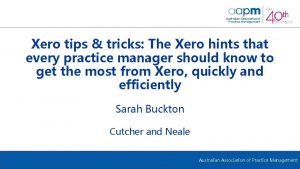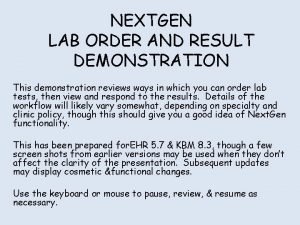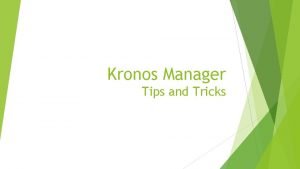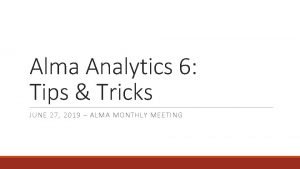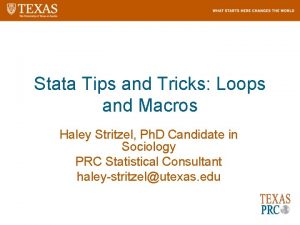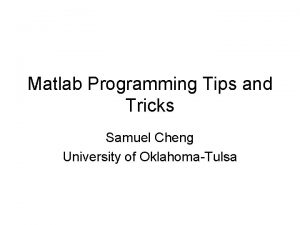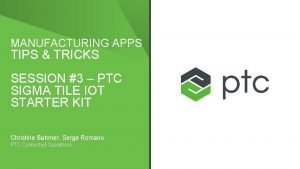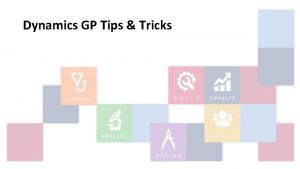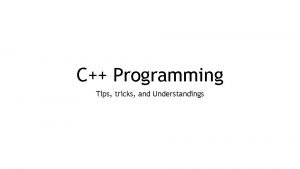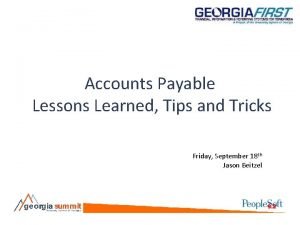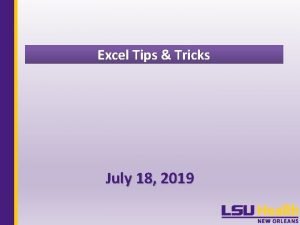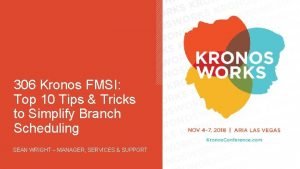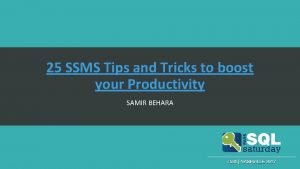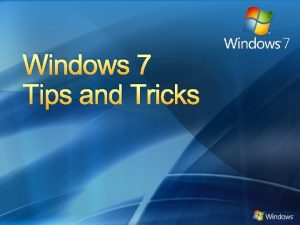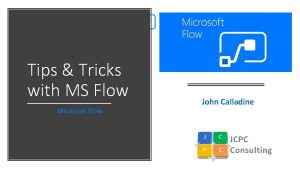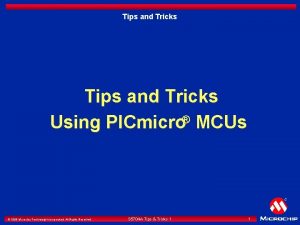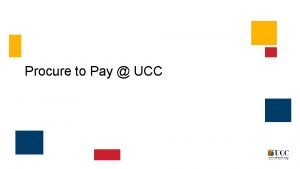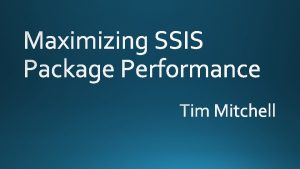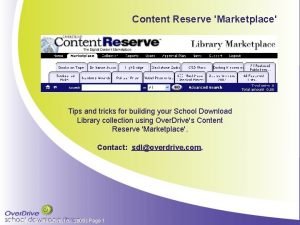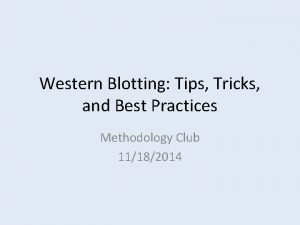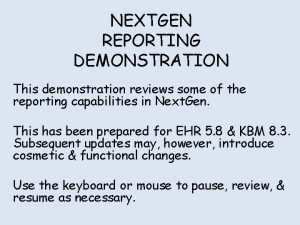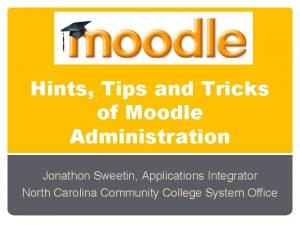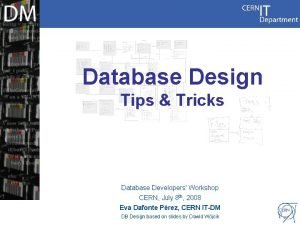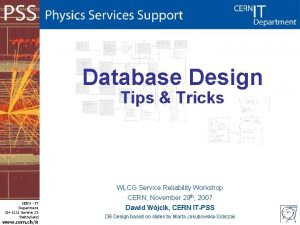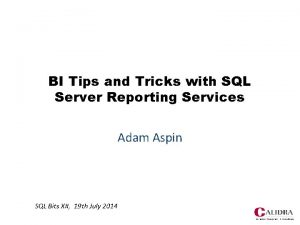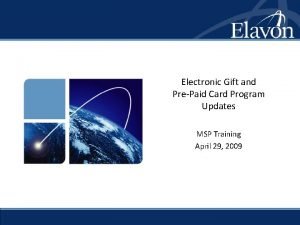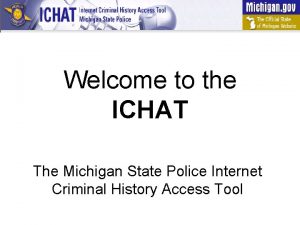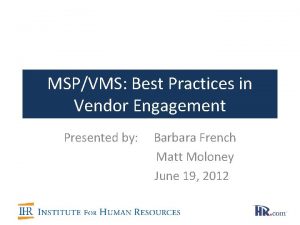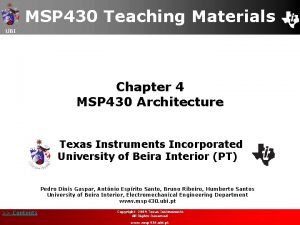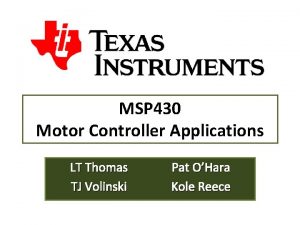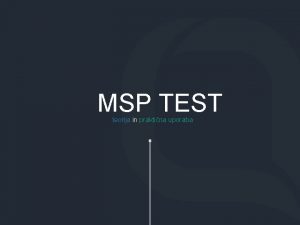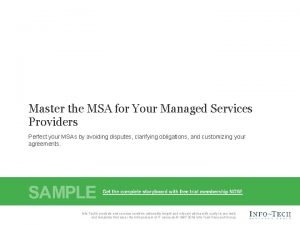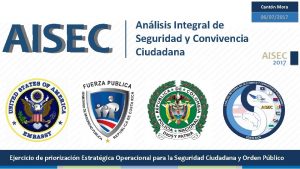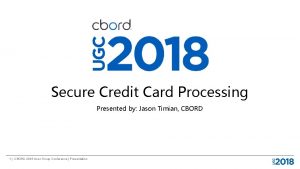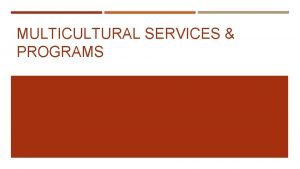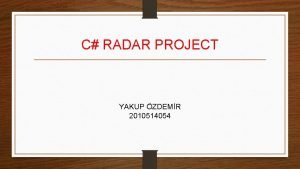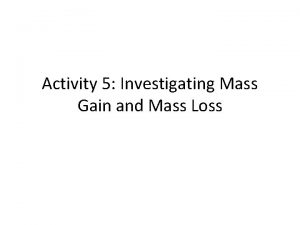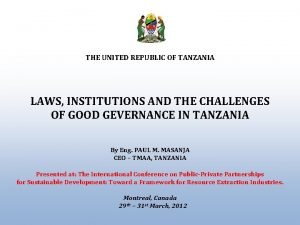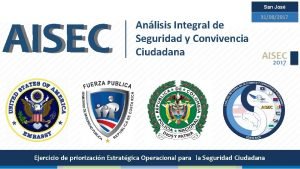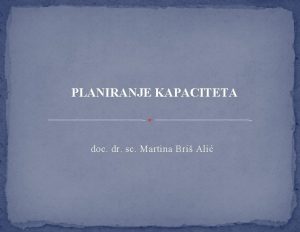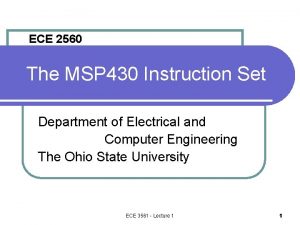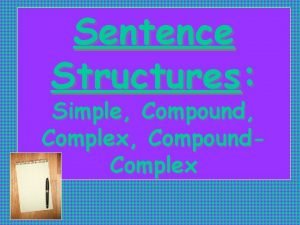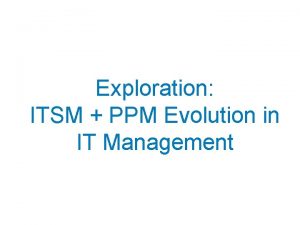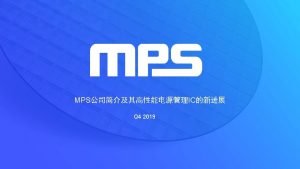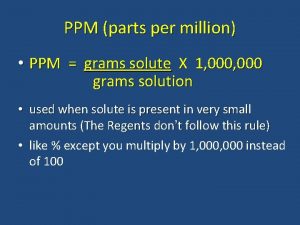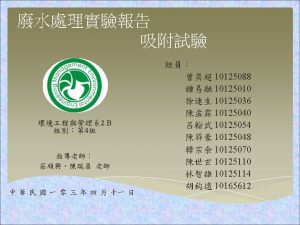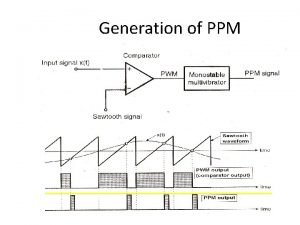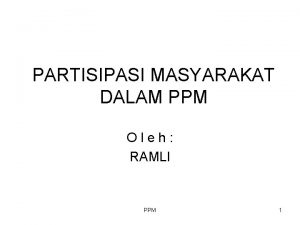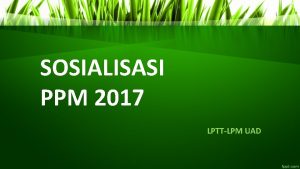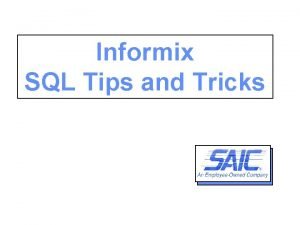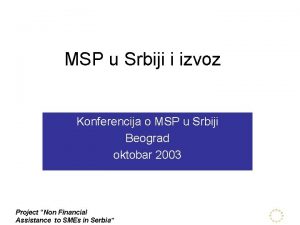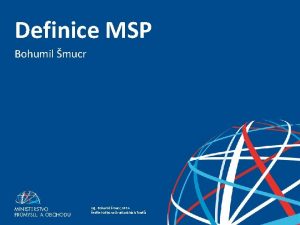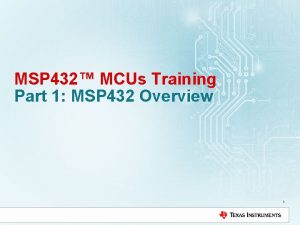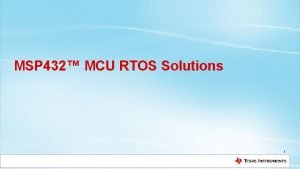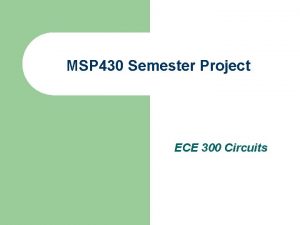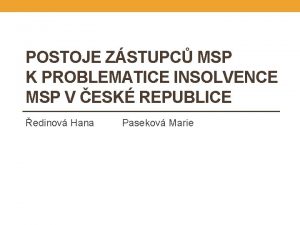MSP With CA PPM Tips And Tricks Your
























































































- Slides: 88

MSP With CA PPM | Tips And Tricks Your Guide: Lisa Olsen

Agenda • CA PPM Scheduling Options • Tasks � MSP Task Don’ts � Task Types � Loading Pattern/Work Contour � Effort Driven Scheduling � Task Constraints � Milestones • XML vs COM Driver • Installing the MSP Interface • Options and Settings • MSP Organizer • Improving Performance • Opening and Saving a Project Schedule • How Do Actuals Affect Project Schedules? • Projects • Prior Start and Prior Finish Fields � Master and Subprojects � Baselines � Cost Data • Open for Time Entry Field • Maintaining the Project Schedule • Mapping Custom Fields • Resources � Allocation, Max Units and Assignment Units � Resource Leveling Let Rego be your guide. 2

Why Integrate MSP with CA PPM? • Full bidirectional connection between CA PPM and MSP • Stop relying on multiple spreadsheets and applications for data • Real-time progress updates on MSP project schedule through CA PPM Timesheets • Repeatable processes and centralized data are essential in providing accurate reports and actionable metrics • MSP is an industry standard and widely used by most Project Managers Let Rego be your guide. 3

CA PPM Scheduling Options Let Rego be your guide. 4

CA PPM Scheduling Options 1. CA PPM Gantt – Autoschedule 2. Microsoft Project 2010/2013 3. Open Workbench • Organizations should select ONE CA PPM scheduling option or at the very least, ONE scheduling option per project • Each option uses a different scheduling algorithm, so if a project schedule is opened in one and then another, it will calculate on top of a calculation Let Rego be your guide. 5

CA PPM Gantt: Autoschedule Simple Project Schedules can be updated in CA PPM from the Project > Tasks > Gantt view Autoschedule can be used to updated the project schedule after making changes. You can also review your changes before publishing them as the Plan of Record (POR) Autoschedule will: • Use availability as early in the project as possible • Set start and finish dates based on task constraints • Minimize the duration of the critical path, which will determine the earlies finish date for the project Let Rego be your guide. 6

Open Workbench will update the project schedule based on the number of hours each resource will work per week to cover the total number of hours on the task • Algorithm is Resource Driven • Open Source application – no licensing costs • Fully integrated with CA PPM • Training may be required Let Rego be your guide. 7

Microsoft Project will update the project schedule based on task duration • Algorithm is date driven • Custom fields need to be mapped through the CA PPM User Interface • MSP license required for each user • Additional CA PPM / MSP training may be necessary Let Rego be your guide. 8

XML vs. COM Driver Let Rego be your guide. 9

New XML Driver • Before CA PPM Release 14. 1, there was one MSP Interface driver which was COM-based • In CA PPM Release 14. 1, a new XML-based driver option was introduced to improve performance by opening the project schedule in one large block. • During the installation process, you can choose to install the Legacy “COM-based” driver or the New “XML -based” driver • Both options are available for 32 -bit and 64 -bit environments Let Rego be your guide. 10

New XML Driver vs. Legacy COM Driver • Resource Pools are no longer available for Master Projects; all Resources will be on the Master Resource Sheet • If a Task is created in CA PPM and NOT pinned through a dependency and does NOT start on the Project Start Date, MSP will NOT automatically put a Constraint on the Task • “Number 1” and “Number 2” fields are no longer mapped to the “Proposed ETC” and “Pending Actuals” Fields • Custom Views are no longer saved in the MPP file and should be saved in the Global. mpt file • “Save As” is not available when trying to save a schedule to an EXISTING CA PPM Project • Elapsed Duration values are now preserved between CA PPM and MSP Let Rego be your guide. 11

Installing The MSP Interface Let Rego be your guide. 12

Installation Prerequisites The following third-party software must be installed on the workstation: �MSP 2010 or MSP 2013 �Microsoft. NET Framework 4 http: //www. microsoft. com/downloads/en/details. aspx? Family. ID=0 a 391 abd 25 c 1 -4 fc 0 -919 f-b 21 f 31 ab 88 b 7&displaylang=en �Microsoft Visual Studio 2010 Tools for Office Runtime https: //www. microsoft. com/en-us/download/details. aspx? id=48217 Java Runtime (JRE) is now included in the CA PPM download and is copied to the MSP Interface Installation directory on the workstation’s hard drive, eliminating all of the prior issues related to the JRE version incompatibility Let Rego be your guide. 13

Installing The MSP Interface and Schedule Connect need to be installed on each user’s workstation To determine if you should install Microsoft Project Interface (x 86) or Microsoft Project Interface (x 64), you need to determine if MSP was installed as 32 -bit or 64 bit, REGARDLESS of the workstation In Office 2013: 1. Open MSP 2. Click File > Account > About > Program Name In Office 2010: 1. Open MSP 2. Click File > Help You should see the version and whether you are running 32 -bit or 64 -bit under you are running 32 -bit or 64 -bit “About Microsoft Project” Let Rego be your guide. 14

Options and Settings Let Rego be your guide. 15

MSP Related Settings In CA PPM: Admin CA PPM > Administration > Project Management > Settings: Default Load Pattern: This should be set to “Uniform” which will be the default and map to the MSP “Work Contour” field Only Export Current Baselines When Opening Investments in a Scheduler: This should be checked to improve performance MSP Assignment Units Mapping with PPM Assignment “Max % Load”: This should be checked to ensure that the MSP Assignment Unit % does not get overwritten by the Resource Allocation % Let Rego be your guide. 16

MSP Related Settings In CA PPM: Project > Properties > Settings: Scheduler: This must be set to “Microsoft Project” % Complete Calculation Method: This should be set to “Manual” if MSP is being used with CA PPM or if you are using an external job to calculate % Complete. The % Complete field appears on the task properties page Track Mode: This should be set to “Clarity” if CA PPM Timesheets are being used to record time Let Rego be your guide. 17

MSP Options From the MSP Tools menu, select File > Options and refer to the following guidelines so MSP and CA PPM will effectively work together Date Format: The storage of dates and timestamps are not consistent between tables in CA PPM. Some dates, like Task Start and Finish Dates, are recorded with specific timestamps. Some dates are recorded as the correct date with a timestamp of midnight. Some dates are recorded as a “plus 1” date, which means that the date stored in the table is one day later with a midnight timestamp. To avoid discrepancies, it is NOT recommended to use a date format with a timestamp General Tab: Let Rego be your guide. 18

MSP Options Calendar Options: The “Week starts on” and “Fiscal year starts in” calendar fields should match your calendar settings in CA PPM. The other MSP calendar fields will map through the integration Schedule Tab: Scheduling Options for this Project: This should be set to “All New Projects” in order for the settings to be effective for all new projects and not just the one that is open New Tasks Created: Automatic calculation is the preferred setting, but it is not required. If you select Manual Calculation, you must manually calculate the project before saving it to CA PPM (more info on next slide) Duration is entered in: Duration should be tracked in days since this is the lowest level that CA PPM is able to track Split in-progress Tasks: Helps fill in the work gaps while using Resource Leveling Let Rego be your guide. 19

Manually Scheduled Tasks can be set to “Manually Scheduled” from MSP Options. This allows you to enter data like you would in Excel where tasks are not calculated. Save to CA PPM: Open back up in MSP: Let Rego be your guide. 20

MSP Options Scroll Down on Schedule Tab…. . Calculation Options for this Project: This should be set to “All New Projects” in order for the settings to be effective for all new projects and not just the one that is open. Schedule Alerts Options: This should be set to “All New Projects” in order for the settings to be effective for all new projects and not just the one that is open. Calculate Project after each Edit: If “On” is selected, the project will automatically calculate after each edit. If set to “Off”, task scheduling that occurs as a result of task dependencies (predecessors) will be turned off within MSP as well as when a project schedule is re-opened from CA PPM to MSP (more info on next slides). Let Rego be your guide. 21 Updating Task status updates Resource Status: If checked, resource actuals, remaining work (ETC), and costs are automatically updated when percent complete, actual duration, or remaining duration is updated. This open should ONLY be checked when Actual hours are NOT being tracked through CA PPM timesheets. (more info on next slides) Inserted Projects are calculated like Summary Tasks: If checked, on a master project, project will display a single critical path for the Master Project and all of its sub-projects.

Calculation Mode: Off (Manually Scheduled) If the MSP Calculation Mode is set to “Off” (manual), tasks will NOT be adjusted based on their dependencies and the project schedule will stay as it was last saved in CA PPM, if you don’t have any Actuals from Timesheets. Save the Project Schedule to CA PPM: Open Project Schedule from CA PPM to MSP: Let Rego be your guide. 22

Calculation Mode: Off (Manually Scheduled) The following are exceptions that apply with Manual Calculation: • CA PPM Timesheet Actuals can shift Task Dates • Resource Leveling will still recalculate the project schedule • Task Constraints may shift Task Dates Let Rego be your guide. 23

Updating Task Status Updates Resource Status If the CA PPM Track Mode is set to “Clarity” or “CA PPM”, this option should be UNCHECKED in MSP > File > Options > Schedule: The “Updating Task status updates resource status” feature in MSP automatically updates the status of projects when the “% Complete” field is updated If 25% is entered as the “% Complete” on a 40 hour task, MSP will automatically update Actuals with 10 hours and change Remaining Work to 30 hours When the project schedule is saved back to CA PPM, those Actuals will get dropped (not saved to CA PPM) without an error message, so the PM will be unaware When the schedule is re-opened from CA PPM to MSP, the following may happen: • • • Actual Hours disappeared The Remaining Work field shows the reduced value, and therefore Work will be reduced Task Dates may be rescheduled Let Rego be your guide. 24

MSP Options Save Tab: Save Files in this Format: This option can be changed if you want to save the MPP file in a format that’s compatible with an older version of MSP Default File Location: When saving the MPP file outside of CA PPM, you can change the default location where the file gets saved Let Rego be your guide. 25

MSP Options Allow Cell Drag and Drop: If checked, you can move cells by using the “drag and drop” functionality, moving the task ids with the task. Don’t use the “cut and paste” functionality to move tasks because MSP will change the task unique id which will affect the integration mapping Advanced Tab: Automatically add new views, tables, filters, and groups to the global: (New in MSP 2010): If checked, any changes made to views, tables, filters and groups will automatically be available across your projects. In previous MSP versions, changes needed to be manually copied to the Global. mpt file through the Organizer Let Rego be your guide. 26

MSP Options Scroll Down on Advanced Tab… Show “Links between Projects” dialog box on open: This feature is incompatible with CA PPM external dependencies, and is ignored when selected. Let Rego be your guide. 27

MSP Organizer Let Rego be your guide. 28

MSP Organizer • When customizing views in MSP by rearranging columns or adding and removing fields, the changes are only visible in the project you’re currently working on • You can copy your customization to the Global Template so all the changes are available in future projects, as well as projects that were created in the past • To create a global template, open an empty project or the project that has the customization directly from MSP, go to File > Info > Organizer Let Rego be your guide. 29

MSP Organizer • Once the changes are made, you can see the active project’s customizations on the right-side panel of the Organizer �From the “Views” tab, highlight all of the views from the right-side panel and then click “<<Copy” �Do the same for the “Tables” tab Let Rego be your guide. 30

MSP Organizer • In Microsoft Project 2010, the organizer behaves a bit differently �By default, new views are automatically saved to the global template file and are made available to future projects (as are new tables associated with the view) �To change this setting, on the File tab, click Options, and then click Advanced. Find the setting in the Display section �Changes to existing view elements are not automatically saved to the Global template with this setting. This only applies to NEW views, tables, filters and groups Let Rego be your guide. 31

Improving Performance Let Rego be your guide. 32

Improving Performance • How can you decrease the amount of time it takes to export a project schedule from CA PPM to MSP? �Set the CA PPM default loading pattern to “Uniform” – which will map to a “Flat” work contour in MSP �Select Only Export Current Baselines When Opening Investments in a Scheduler in CA PPM Administration > Project Management > Settings �Remove unnecessary assignments �Increase the memory on the workstation to at least 512 MB (ideally 1 GB) Let Rego be your guide. 33

Opening And Saving A Project Schedule Let Rego be your guide. 34

Open A Project Schedule From CA PPM… From MSP… Choose either (Read-Write) or (Read. Only) from the Project > Properties or Tasks tab: Choose “Open” from the CA PPM Integration menu: You may be asked to login to CA PPM The CA PPM “Scheduler Format” in Project > Properties needs to be set to “Microsoft Project” Let Rego be your guide. Choose the project from the “Open from Clarity” selection box 35

Open A Project Schedule When opening a project schedule from CA PPM to MSP, the following occurs: • If the project was previously saved from MSP to CA PPM, the latest “. mpp” file from the CA PPM database is downloaded and will overwrite/copy the “. mpp” file to the local drive • The MSP schedule will then be updated with any data changes that were made directly in CA PPM since the “. mpp” file was last saved. • • Let Rego be your guide. Actuals Posted from Timesheets Task Level Updates Project Team Updates Resource Assignment Updates 36

Save A Project Schedule The “Save” button will save your MSP Project Schedule back to CA PPM: When an MSP schedule is saved to CA PPM, a copy of the MPP or XML file is saved to the CA PPM database where all unmapped fields and global settings are preserved Let Rego be your guide. 37

Save A Project Schedule The “Save As” button will allow you to: • Save copies of existing CA PPM Projects as New Projects in CA PPM (Save As) • Save new projects to CA PPM from MSP (Save As) The NEW XML version of the MSP Interface will NOT allow you to use “Save As” to save a schedule over an existing CA PPM project Let Rego be your guide. 38

What Data Is Saved From MSP To CA PPM All Task and Assignment data in MSP is saved back to CA PPM, EXCEPT: • Charge Codes • Actual Hours (if track mode is set to PPM) • Unplanned Tasks and Assignments – Tasks with hours, but no resource assignment • Manual edits to the Baseline Let Rego be your guide. 39

MSP Working Copies • If you would like to work on the project schedule offline or disconnected from CA PPM, you can: �Open the Project from CA PPM to MSP in Read/Write mode �From the MSP file menu, click File > Save As and select a location on your local hard drive �Exit out of MSP • You can now work on the project schedule that was saved to your local drive �CA PPM will maintain a lock on the project until it is successfully saved back to CA PPM • When you’re ready to save it back to CA PPM, open the file and click on “Save” under the CA PPM Integration Toolbar �You may need to log back into CA PPM Let Rego be your guide. 40

Projects Let Rego be your guide. 41

Master And Subprojects • The Master Project should be created as a “shell” in CA PPM. Do not add staff to the Project Team, create tasks or track actuals in the Master Project • Create or identify the Sub-Projects and add them to the Master Project from Project > Properties > Subprojects • Add many subprojects to a master project Let Rego be your guide. 42

Master Projects In MSP • When a Master Project is opened from CA PPM to MSP, all related sub-projects are also opened • Resources from all sub-projects are merged and added to the Master Project’s resource sheet in MSP, but are not copied back to CA PPM when saved • If there are no assignments for a particular team member, they are removed from the sub-project’s team when saved to CA PPM • Sub-Project schedules can be opened and worked on independently Let Rego be your guide. 43

Baselines can be created in either CA PPM or in MSP • CA PPM supports unlimited baselines • MSP supports 11 baselines In MSP, go to Tools > Tracking > Save Baseline In CA PPM, go to Projects > Properties > Baseline To avoid performance issues, you should only download the current baseline Administration > Project Management > Settings: Let Rego be your guide. 44

Cost Data Cost Information in MSP is retrieved from the Financial Cost Matrix in CA PPM. Cost rates determine the cost that is associated with a resource assigned to a task Costs are shown over time by Task and at the Project Level Any changes that are made to cost rates directly in MSP are for “What-if” purposes only and WILL NOT be saved back to CA PPM Let Rego be your guide. 45

Resources Let Rego be your guide. 46

Resources should be added in CA PPM before the project schedule is opened in MSP Resource and Calendar Data should be updated and maintained in CA PPM. Changes made in MSP will not be copied back to CA PPM. This does not apply to Resource Assignment information on Tasks. Let Rego be your guide. 47

Allocation, Max Units And Assignment Units Allocation (CA PPM) – the expected amount of time that a resource is expected to work on the project Max Units (MSP) – the maximum percentage of working time that a resource is available to work on project tasks Assignment Units (MSP) – the percentage of working time that a resource is assigned to work on that one task Let Rego be your guide. 48

Max Units • Average Allocation % and Allocation Hours from CA PPM Team Page: �MSP Resource Sheet – Max Units: �The 36% comes from the Allocation % Segment that matches the current date �In CA PPM, it’s displayed to the hundredths, but is rounded to a whole number in MSP Let Rego be your guide. 49

Assignment Units In previous CA PPM versions, the Task Assignment Unit % would get over-written with the Allocation % To prevent this from happening, your CA PPM Administrator can check the following option from: Administration > Project Management > Settings: Let Rego be your guide. 50

Assignment Units • When Tasks are created and resources are assigned, the Assignment Units for each resource is defaulted from their Max Units • The two tasks below were entered with 40 hours of work and then assigned to each resource • Since Jerry’s Assignment Units is 100% on a 40 Work Hour task, the Task Duration was calculated to be 5 days • Since Lisa’s Assignment Units is 36% on a 40 Work Hour task, the Task Duration was calculated to be 14 days The Assignment Units for a resource on a task can be changed when assigning the resource to the task. This will not change the Max Units Let Rego be your guide. 51

Resource Leveling in MSP is the process of delaying or splitting a resource’s work on a task to resolve over-allocation • Level Resource – resolves conflicts for the selected Resources only • Level All – resolves conflicts for the entire project The results of Resource Leveling may be significant on a project schedule, but resource leveling does not change who is assigned to tasks, the total work or Assignment Unit values Let Rego be your guide. 52

Tasks Let Rego be your guide. 53

CA PPM vs. MSP Terminology CA PPM MSP Total Usage Work ETC Remaining Work Actuals Actual Work Project Team Allocation % Max Units Max % Load Assignment Units Let Rego be your guide. 54

MSP Task “Don’ts” • Do Not Assign Resources to a Summary Task – This is allowed in MSP, but not in CA PPM. You will get the “Summary Task Assignments are not Supported” error • Do Not put ETC/Remaining Work on a Milestone – The milestone will turn into a task the next time the schedule is opened from CA PPM to MSP • Do Not put Actual Hours on a Milestone – If hours are added to a Milestone without a Resource Assignment, the Actual Hours will stay on the Milestone in MSP. If hours are added to a Milestone with a Resource Assignment, the Hours won’t stay in MSP after a save to CA PPM Let Rego be your guide. 55

Task Types • MSP uses the following scheduling formula when calculating tasks: �Work = Duration x Assignment Units • Each value of the formula corresponds to a Task Type: �Fixed Work �Fixed Duration �Fixed Units • Which task type should be used? �It depends on the processes in the organization Let Rego be your guide. 56

Fixed Work • If work hours are used to estimate how long deliverables will take on a project based on resource assignment • All Fixed Work tasks are Effort Driven Example: �Team Leads will look at project requirements and provide an estimate in hours for each project deliverable �Project Managers will estimate how many hours each deliverable will take based on experience or a project sizing tool Let Rego be your guide. 57

Fixed Duration • If Duration (number of days) is used to estimate how many hours deliverables will take to complete based on resource assignment Example: �Team Leads will provide the estimated number of days or weeks that deliverables will take to complete �Project Managers will estimate how many days each deliverable will take based on experience or a project sizing tool Let Rego be your guide. 58

Fixed Unit • If resources are managed and allocated to projects based on a percentage of their time or if projects are estimated based on the number of resources needed in each role, then “Fixed Units” would work Example: �“Resource A” is assigned to a project for 100% of their time to work on tasks. It’s the Resource Manager’s responsibility to make sure they are adequately utilized �Projects are estimated and staffed with one Project Manager, two Business Analysts, four Software Engineers, etc. Let Rego be your guide. 59

Loading Pattern / Work Contour CA PPM calls it a “Loading Pattern”… MSP calls it “Work Contour”… Whatever terminology is used, they both mean the same thing…. . It dictates how resource work hours are scheduled over time CA PPM’s “Loading Pattern” field maps to MSP’s “Work Contour” field Let Rego be your guide. 60

Loading Pattern / Work Contour Recommended Default Load Pattern is “Uniform” CA PPM Administrator can set the default from Administration > Project Management > Settings: The reasons for this recommendation: • Due to the way Microsoft Project distributes estimate to complete (ETC) when using both front and back contour patterns, and • Performance when opening from and saving to CA PPM Saa. S Let Rego be your guide. 61

Loading Pattern / Work Contour If you first create the task assignment in Microsoft Project: Work Contour in Loading Pattern in Microsoft Project CA Clarity PPM Flat becomes Uniform Front becomes Front Back becomes Back The msp specific work contour designated on the task when it was first created in MSP. (Turtle, Bell, etc…) becomes Contour Let Rego be your guide. 62

Loading Pattern / Work Contour • Fixed Loading Pattern – remaining ETC gets dropped if someone charges less hours than what was planned. Will affect the forecast • Project Templates will use the Load Pattern from when the Template was created. The default Load Pattern needs to be set before creating the template…. Let Rego be your guide. 63

Effort Driven Scheduling Effort Driven scheduling ONLY applies AFTER the initial resource assignment is made, even if you initially add more than one resource Assign an additional resource at 100% to the tasks Note: “Fixed Work” will force the task to be “Effort Driven”, so if “Fixed Work” is chosen as the default, all tasks will automatically be “Effort Driven” Let Rego be your guide. 64

Task Constraints • All “automatically” scheduled tasks will have an “As soon as possible” constraint • If tasks are created in CA PPM or copied from a template and the Task Start Date is not the same as the Project Start Date, MSP will place a “Start No Earlier” constraint on the Task when the Project Schedule is first opened from CA PPM to MSP • This applies to the Legacy Driver ONLY; no constraints will be applied using the new XML driver Constraint Types As Late As Possible Forces a task to start on a date in order for it to finish before the end of the project Finish No Earlier Than/Finish No Later Than Sets the completion of the task to fall no sooner or no later than the specified date Must Finish On/Must Start On Forces a task to Finish or Start on the specified date Start No Earlier Than/Start No Later Than Sets the start of the task to fall no sooner or later than the specified date Let Rego be your guide. 65

Milestones • Milestones are a point in time and do not have a duration or work assigned to them • In MSP, you can identify a Task as a Milestone from Task Information > Advanced or by adding the Milestone field column in one of the MSP task views • • • Milestones can be linked to other tasks/milestones Resource(s) can be assigned to a Milestone DO NOT enter a Duration or Work on a Milestone Let Rego be your guide. 66

Elapsed Duration can be entered in MSP as Working Days or Elapsed (Calendar) Days, which is the amount of time that a task should take to finish based on a 7 day / 24 hour schedule, including holidays and non-working time In MSP, the Duration can be entered as “ 3 ed” to reflect Elapsed Duration instead of “ 3 d” The NEW XML driver with MSP 2010 or later will retain the Elapsed Duration The Legacy COM driver DOES NOT retain the values from MSP to CA PPM and will be converted to Working Days in CA PPM Let Rego be your guide. 67

How do Actuals Affect Project Schedules? Let Rego be your guide. 68

How do Actuals Affect Project Schedules? 1. Resources assigned to tasks will submit their hours through CA PPM Timesheets 2. Timesheets will get Approved and then Posted 3. When a timesheet is Posted, the ETC field is modified on any task assignment that has Actuals If the task assignment has Loading Pattern/Work Contour of Fixed in CA PPM or Contoured in MSP, planned ETC that WAS NOT submitted as Actuals by that Resource will be removed, which may decrease the Total Work (Effort) on that task Let Rego be your guide. 69

How do Actuals Affect Project Schedules? Loading Patterns/Work Contours are set to “Contoured” in MSP if Assignment Hours are modified through the Resource Usage View If a Resource submits a timesheet without any hours charged to a particular task that was assigned to them with ETC for that week, those hours will get pushed out and redistributed throughout the remaining duration on that task or dropped depending on the Loading Pattern/Work Contour Actuals posted to one task may affect the dates of another task if they are dependent on one another Let Rego be your guide. 70

Actuals: Same Number of Hours as Planned • Resource submitted their timesheet with the same number of hours assigned • Assigned Hours vs. Actual Hours: Thu 1/23 Fri 1/24 Mon 1/27 Tue 1/28 Wed 1/29 Thu 1/30 Assigned Hours 8 8 8 Hours Entered on Timesheet 8 8 • Results: Let Rego be your guide. 71

Actuals: Fewer Hours than Planned • Resource submitted their timesheet with FEWER hours than assigned • Assigned Hours vs. Actual Hours: Thu 1/23 Fri 1/24 Mon 1/27 Tue 1/28 Wed 1/29 Thu 1/30 Assigned Hours 8 8 8 Hours Entered on Timesheet 8 8 4 • Results: Since only 4 of the 8 hours that were assigned were recorded, the duration increased by. 5 days for both the Fixed Units and Fixed Work Task Types Let Rego be your guide. 72

Actuals: Fewer Hours than Planned (cont’d) • The Fixed Duration task didn’t change the duration, but distributed the additional 4 hours over the last two days so Work is now 10 hours for Tuesday and Wednesday Let Rego be your guide. 73

Actuals: More Hours than Planned • Resource submitted their timesheet with MORE hours than assigned • Assigned Hours vs. Actual Hours: Thu 1/23 Fri 1/24 Mon 1/27 Tue 1/28 Wed 1/29 Thu 1/30 Assigned Hours 8 8 8 Hours Entered on Timesheet 8 8 4 12 • Results: The Fixed Units and Fixed Work task Durations went back down to 5 days since the resource “caught” up Let Rego be your guide. 74

Actuals: More Hours than Planned (cont’d) • The Fixed Duration assigned hours for Wednesday went back down to 8 hours since the resource submitted additional hours the day before Let Rego be your guide. 75

Actuals: Skipped a Planned Day • Resource skipped the last day of assigned work and then entered fewer hours on the day after the task was supposed to finish • Assigned Hours vs. Actual Hours: Thu 1/23 Fri 1/24 Mon 1/27 Tue 1/28 Wed 1/29 Thu 1/30 Assigned Hours 8 8 8 Hours Entered on Timesheet 8 8 4 12 0 4 Fri 1/31 • Results: Since zero hours were recorded on Wednesday, the task gets split �Fixed Units and Fixed Work task types will calculate Duration without counting the days in between the split �Fixed Duration tasks WILL count the days in the middle of the split Let Rego be your guide. 76

Actuals: Skipped a Planned Day (cont’d) • The Task Finish Dates all changed to Friday, 1/31, to accommodate the extra 4 hours needed to complete the task Let Rego be your guide. 77

Prior Start And Prior Finish Fields One of the biggest complaints from Project Managers is that CA PPM changed their MSP task dates in their project schedule • When many task dates change, it’s difficult for the PM to find the root cause • By default, Task Start and Finish Dates are already mapped between CA PPM and MSP �Those dates may change as Actuals are applied to the project schedule • You can extend the mapping table with the following MSP fields to make it easier: Start 10 Prior Start Finish 10 Prior Finish Let Rego be your guide. 78

Prior Start and Prior Finish Fields • The extended mapping should NOT be bi-directional; it should be on “Export from CA PPM” only • When a project schedule is exported from CA PPM to MSP, the Task Start and Finish Dates will be copied to both the MSP Start and Finish fields as well as the new Start 10 and Finish 10 fields • The Actuals are then applied to the schedule which may cause the original Task Start and Finish Dates to change, but not the new Start 10 and Finish 10 fields Let Rego be your guide. 79

Prior Start And Prior Finish Fields • The Project Manager is now able to compare the following fields to find the first task with a difference Start >> Finish >> Prior Start Prior Finish • You can then look at that task and any predecessors to see what Actuals were applied that caused the dates to change Let Rego be your guide. 80

Open For Time Entry Field • You can extend the mapping table by adding the “Open for Time Entry” (Flag 11) field so Project Managers can better control what tasks are open for time entry from MSP • This should be a bidirectional mapping so the data flows from CA PPM to MSP and from MSP to CA PPM • In CA PPM, the Open for Time Entry field defaults to “Yes” for new tasks and in MSP it defaults to “No” for new tasks Let Rego be your guide. 81

Maintaining The Project Schedule Let Rego be your guide. 82

Maintaining the Project Schedule Once a resource charges time to a project and those hours are posted as Actuals, the Project Manager needs to frequently maintain the project schedule �Step 1: Open the Project Schedule from CA PPM to MSP �Step 2: Review new Actual Work Hours to ensure they look accurate �Step 3: For Tasks that are Complete: Verify that the Remaining Work field is zero (0) o If there are hours, enter zero (0), which will reduce the Work field so it matches the Actual Work field 1. Enter “ 100%” in the “% Complete” field 2. Mark the task as “Not Open for Time Entry” Let Rego be your guide. 83

Maintaining The Project Schedule Step 3 – For Tasks that are Complete, cont. • To “Close” this Task: • Work was planned to take 40 hours, but the task was completed with 16 hours: • Right Way Enter “ 0” for Remaining Work Enter “ 100” for % Complete • Wrong Way Enter “ 100” for % Complete Let Rego be your guide. 84

Maintaining The Project Schedule Step 4: For Tasks that are still in progress: • Adjust any Work hours that need to be increased • Verify that all tasks have values in the Remaining Work field • Reschedule any task with a “Finish Date” in the past • Reschedule any task with a “Start Date” in the past that hasn’t started yet Let Rego be your guide. 85

Copy Or Move A Task Copy a Task: You CAN use copy/paste to create a NEW Task �New IDs will be given to the copied task Move a Task: Use the Drag and Drop functionality to move a task DO NOT use cut/paste to move a task in the project schedule �This will change the unique Task ID that is used by the CA PPM – MSP Integration Let Rego be your guide. 86

Custom Field Mapping Custom Fields can be easily mapped between CA PPM and MSP from CA PPM – Administration > Project Management > MSP Field Mappings: Let Rego be your guide. 87

Thank You For Attending rego. University Instructions for PMI credits Phone • Access your account at pmi. org 888. 813. 0444 • Click on Certification • Click on Maintain My Certification • Scroll down to Report PDU’s Email • Select Education-Category B-Continuing Education or Category C-Self-Directed Learning info@regouniversity. com • 1 PDU per hour Website • Class Name = rego. University www. regouniversity. com • Course Number = Session Number • Date Started = Today’s Date • Date Completed = Today’s Date • Hours Completed = 1 PDU per hour of class time Let Rego be your guide. 88
 Xero tips and tricks
Xero tips and tricks Alteryx tips and tricks 2021
Alteryx tips and tricks 2021 Next gen lab
Next gen lab Kronos tips and tricks
Kronos tips and tricks Igcse english tips
Igcse english tips Homework
Homework Navision tips and tricks
Navision tips and tricks Chemdraw tips and tricks
Chemdraw tips and tricks Alma analytics tips and tricks
Alma analytics tips and tricks Magento tips and tricks
Magento tips and tricks Stata tips and tricks
Stata tips and tricks Data analysis tricks
Data analysis tricks Matlab tips and tricks
Matlab tips and tricks Ptc manufacturing apps
Ptc manufacturing apps Accessibility tips and tricks
Accessibility tips and tricks Google scholar tips and tricks
Google scholar tips and tricks Qlik sense tips
Qlik sense tips Gp tips and tricks
Gp tips and tricks Vacuum forming tips and tricks
Vacuum forming tips and tricks C programming tricks
C programming tricks Wells fargo positive pay file format
Wells fargo positive pay file format Wpf tips and tricks
Wpf tips and tricks Math uil test
Math uil test Branding tips and tricks
Branding tips and tricks Excel tips and tricks 2019
Excel tips and tricks 2019 Kronos tips and tricks
Kronos tips and tricks Ssms tips and tricks
Ssms tips and tricks Windows 7 tips and tricks
Windows 7 tips and tricks Vmware tips and tricks
Vmware tips and tricks Pseudolabeling
Pseudolabeling Microsoft flow tips and tricks
Microsoft flow tips and tricks Koststed
Koststed Microchip tips and tricks
Microchip tips and tricks Agresso ucc
Agresso ucc Troubleshooting ssis package performance
Troubleshooting ssis package performance Content reserve
Content reserve Western blot tips and tricks
Western blot tips and tricks Train the trainer tips and tricks
Train the trainer tips and tricks Nextgen reporting
Nextgen reporting Cecos moodle
Cecos moodle Sketchup tips and tricks
Sketchup tips and tricks Database design tips and tricks
Database design tips and tricks Database design tips
Database design tips Visual studio 2010 tips and tricks
Visual studio 2010 tips and tricks Ssrs report design layout tricks
Ssrs report design layout tricks The 30 greatest lead generation tips tricks & ideas
The 30 greatest lead generation tips tricks & ideas Managed services presentation
Managed services presentation Organigramme sante
Organigramme sante Msp gift card
Msp gift card Pega predictive diagnostic cloud
Pega predictive diagnostic cloud Ichat michigan login
Ichat michigan login Msp vms best practices
Msp vms best practices Msp 430 architecture
Msp 430 architecture Msp in a group motor application
Msp in a group motor application Msp 32
Msp 32 Msp online
Msp online Msp test
Msp test Msp master service agreement
Msp master service agreement Datapol msp
Datapol msp Msp burnout
Msp burnout Bitdefender cloud backup
Bitdefender cloud backup Application visualization for msp
Application visualization for msp Freedom pay credit card processing
Freedom pay credit card processing Msp uga
Msp uga Msp radar
Msp radar Msp
Msp Shoulder x ray positioning lateral
Shoulder x ray positioning lateral Msp project
Msp project Datapol msp
Datapol msp Pravilnik za mikro pravna lica
Pravilnik za mikro pravna lica Miejska szkoła podstawowa nr 2 w knurowie
Miejska szkoła podstawowa nr 2 w knurowie Kfv msp
Kfv msp Izgradnja i opremanje proizvodnih kapaciteta
Izgradnja i opremanje proizvodnih kapaciteta Prva primena msfi za msp
Prva primena msfi za msp Msp definice
Msp definice Recumbent position
Recumbent position Msp430 instruction set
Msp430 instruction set Give us your hungry your tired your poor
Give us your hungry your tired your poor Definition of compound complex
Definition of compound complex Ppm fasa 1
Ppm fasa 1 Itsm and ppm
Itsm and ppm Ppm advantages and disadvantages
Ppm advantages and disadvantages What is the example of ideal self
What is the example of ideal self Stupid spherical harmonics (sh) tricks
Stupid spherical harmonics (sh) tricks Magic three smiley face trick
Magic three smiley face trick Smiley face trick examples
Smiley face trick examples A splash of color can bring your desserts to life.
A splash of color can bring your desserts to life. Kekec tricks
Kekec tricks Kekec's tricks
Kekec's tricks
